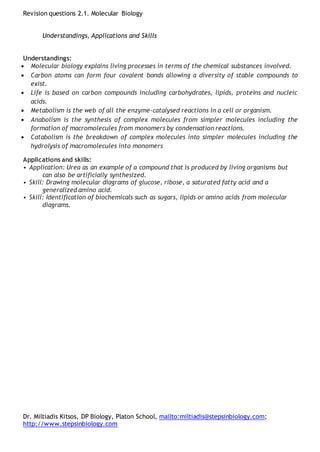
Revision questions on Topic 2.1. From Molecules to Metabolism
- 1. Revision questions 2.1. Molecular Biology Dr. Miltiadis Kitsos, DP Biology, Platon School, mailto:miltiadis@stepsinbiology.com; http://www.stepsinbiology.com Understandings, Applications and Skills Understandings: Molecular biology explains living processes in terms of the chemical substances involved. Carbon atoms can form four covalent bonds allowing a diversity of stable compounds to exist. Life is based on carbon compounds including carbohydrates, lipids, proteins and nucleic acids. Metabolism is the web of all the enzyme-catalysed reactions in a cell or organism. Anabolism is the synthesis of complex molecules from simpler molecules including the formation of macromolecules from monomers by condensation reactions. Catabolism is the breakdown of complex molecules into simpler molecules including the hydrolysis of macromolecules into monomers Applications and skills: • Application: Urea as an example of a compound that is produced by living organisms but can also be artificially synthesized. • Skill: Drawing molecular diagrams of glucose, ribose, a saturated fatty acid and a generalized amino acid. • Skill: Identification of biochemicals such as sugars, lipids or amino acids from molecular diagrams.
- 2. Revision questions 2.1. Molecular Biology Dr. Miltiadis Kitsos, DP Biology, Platon School, mailto:miltiadis@stepsinbiology.com; http://www.stepsinbiology.com Molecular biology explains living processes in terms of the chemical substances involved 1. Explain the reductionist approach that molecular biologists use. …………………………………………………………………………………… …………………………………………………………………………………… …………………………………………………………………………………… …………………………………………………………………………………… …………………………………………………………………………………… …………………………………………………………………………………… 2. Explain how the reductionist approach contrasts the concept of emerging properties in biology. …………………………………………………………………………………… …………………………………………………………………………………… …………………………………………………………………………………… …………………………………………………………………………………… …………………………………………………………………………………… …………………………………………………………………………………… Urea as an example of a compound that is produced by living organisms but can also be artificially synthesized. 3. Urea is produced in the liver but is also produced artificially. Distinguish between the two processes and outline their purpose. …………………………………………………………………………………… …………………………………………………………………………………… …………………………………………………………………………………… …………………………………………………………………………………… …………………………………………………………………………………… …………………………………………………………………………………… 4. Define vitalism and explain how the artificial synthesis of urea falsified the theory of vitalism. …………………………………………………………………………………… …………………………………………………………………………………… …………………………………………………………………………………… …………………………………………………………………………………… …………………………………………………………………………………… …………………………………………………………………………………… Carbon atoms can form four covalent bonds allowing a diversity of stable compounds to exist.
- 3. Revision questions 2.1. Molecular Biology Dr. Miltiadis Kitsos, DP Biology, Platon School, mailto:miltiadis@stepsinbiology.com; http://www.stepsinbiology.com 5. State the name of the bond shown with the arrow. Figure 1: Methane http://www.gcsescience.com/Methane-Molecule.gif 6. Using information from question 6 state how many of these bonds may be formed by any carbon atom. …………………………………………………………………………………… 7. Explain how the properties of carbon are related to the diversity of carbon compounds. …………………………………………………………………………………… …………………………………………………………………………………… …………………………………………………………………………………… …………………………………………………………………………………… …………………………………………………………………………………… ……………………………………………………………………………………
- 4. Revision questions 2.1. Molecular Biology Dr. Miltiadis Kitsos, DP Biology, Platon School, mailto:miltiadis@stepsinbiology.com; http://www.stepsinbiology.com Life is based on carbon compounds including carbohydrates, lipids, proteins and nucleic acids. 8. Compare the basic features of the following macromoleculues Name Participating elements Building blocks Categories Functions in living organisms Carbohydrates Proteins Lipids Nucleic acids Skill: Drawing molecular diagrams of glucose, ribose, a saturated fatty acid and a generalized amino acid.
- 5. Revision questions 2.1. Molecular Biology Dr. Miltiadis Kitsos, DP Biology, Platon School, mailto:miltiadis@stepsinbiology.com; http://www.stepsinbiology.com 9. The carbon skeletons of a glucose and ribose molecule are given below. Based on the skeletons, draw the molecular formulas of the two molecules 10. Draw a saturated, unsaturated and a polyunsaturated fatty acid. Skill: Identification of biochemicals such as sugars, lipids or amino acids from molecular diagrams. 11.Identify the following chemical groups R-O-H R-CH3 O C CC C C Fructose Glucose
- 6. Revision questions 2.1. Molecular Biology Dr. Miltiadis Kitsos, DP Biology, Platon School, mailto:miltiadis@stepsinbiology.com; http://www.stepsinbiology.com 12.Identify which of following molecules is an amino acid, a fatty acid and a carbohydrate. https://upload.wikimedia.org/wikipedia/commons/thumb/7/7a/L-Phenylalanin_-_L- Phenylalanine.svg/232px-L-Phenylalanin_-_L-Phenylalanine.svg.png http://www.chm.bris.ac.uk/motm/linoleic/linoleic.gif http://www.wpclipart.com/science/atoms_molecules/molecules/fructose.png
- 7. Revision questions 2.1. Molecular Biology Dr. Miltiadis Kitsos, DP Biology, Platon School, mailto:miltiadis@stepsinbiology.com; http://www.stepsinbiology.com 13.Identify the following molecules https://courses.washington.edu/conj/membrane/fattyacid.png https://courses.washington.edu/conj/membrane/fattyacid.png http://www.mathima.be/ftp/organischeverbindingen/glycerol.png https://dlc.dcccd.edu/images/biology/lesson3/dipeptide.jpg
- 8. Revision questions 2.1. Molecular Biology Dr. Miltiadis Kitsos, DP Biology, Platon School, mailto:miltiadis@stepsinbiology.com; http://www.stepsinbiology.com Metabolism is the web of all the enzyme-catalysed reactions in a cell or organism. Anabolism is the synthesis of complex molecules from simpler molecules including the formation of macromolecules from monomers by condensation reactions. Catabolism is the breakdown of complex molecules into simpler molecules including the hydrolysis of macromolecules into monomers. 14.Define metabolism …………………………………………………………………………………… …………………………………………………………………………………… 15.State which of the following processes are mainly anabolic or catabolic Photosynthesis Synthesis of polypeptides at the ribosomes Digestion of proteins Cellular respiration 16.Distinguish between anabolism and catabolism Anabolism Catabolism Purpose Types of reactions (e.g., hydrolysis, condensation) Energetics (energy yield or consumption) Examples
- 9. Revision questions 2.1. Molecular Biology Dr. Miltiadis Kitsos, DP Biology, Platon School, mailto:miltiadis@stepsinbiology.com; http://www.stepsinbiology.com 17. Study the following reaction http://hammerstedt-amy-e- f.brsd.high.schoolfusion.us/modules/locker/files/get_group_file.phtml?gid=3418425&fid=26808529 (a) State the general chemical group of the reactants. …………………………………………………………………………………… (b) State the name of the common chemical groups in all reactants. …………………………………………………………………………………… (c) State whether this is an anabolic or catabolic reaction. Explain your choice …………………………………………………………………………………… …………………………………………………………………………………… …………………………………………………………………………………… (d) State whether this is a condensation or a hydrolysis reaction. Explain your choice …………………………………………………………………………………… …………………………………………………………………………………… ……………………………………………………………………………………
- 10. Revision questions 2.1. Molecular Biology Dr. Miltiadis Kitsos, DP Biology, Platon School, mailto:miltiadis@stepsinbiology.com; http://www.stepsinbiology.com 18. State which of the following is a hydrolysis or a condensation reaction. http://hammerstedt-amy-e- f.brsd.high.schoolfusion.us/modules/locker/files/get_group_file.phtml?gid=3418425&fid=26808529 A: …………………………………………………………………………………… Β: …………………………………………………………………………………… C: ……………………………………………………………………………………
- 11. Revision questions 2.1. Molecular Biology Dr. Miltiadis Kitsos, DP Biology, Platon School, mailto:miltiadis@stepsinbiology.com; http://www.stepsinbiology.com References: Allott, Andrew. Biology: Course Companion. S.l.: Oxford UP, 2014. Print. Paine, Chris . “BioKnowledgy DP Notes 2.1 Molecules to metabolism” Web. 11 Nov 2016. <http://www.slideshare.net/diverzippy/bio-k-dp-notes- 21?ref=http://www.bioknowledgy.info/21-molecules-to-metabolism.html>
